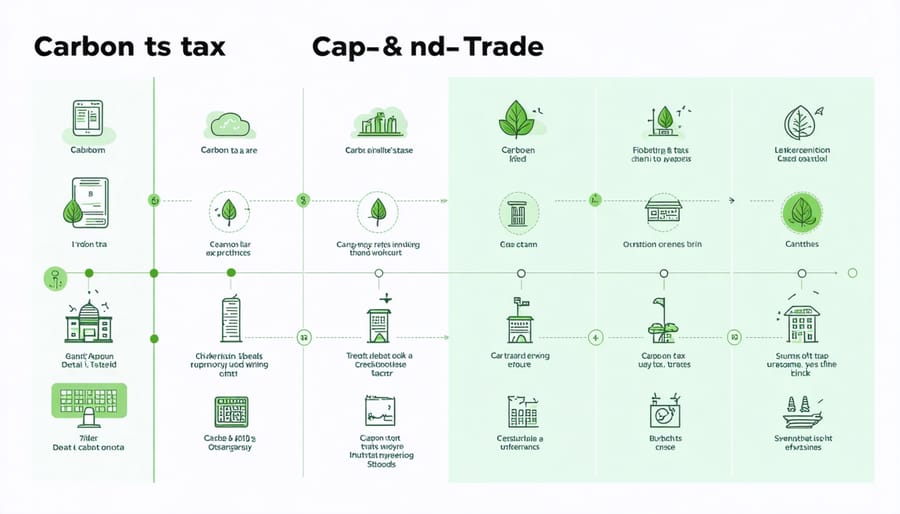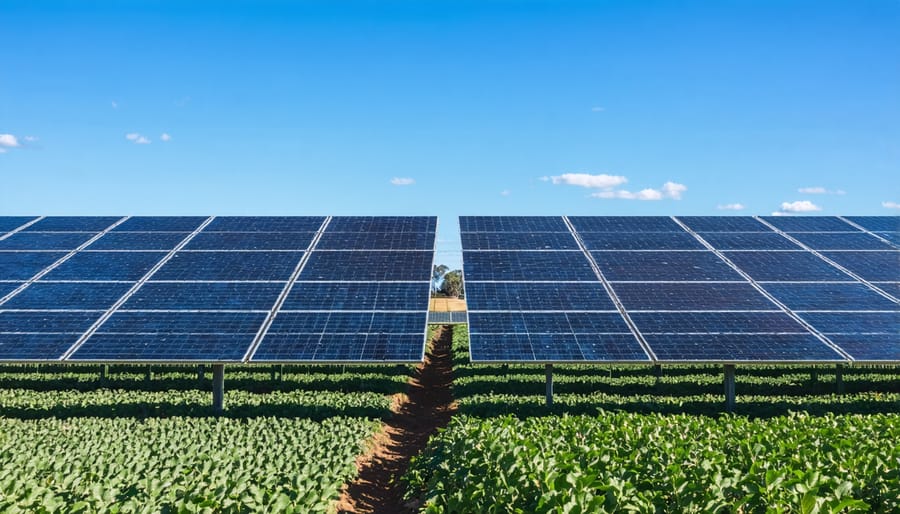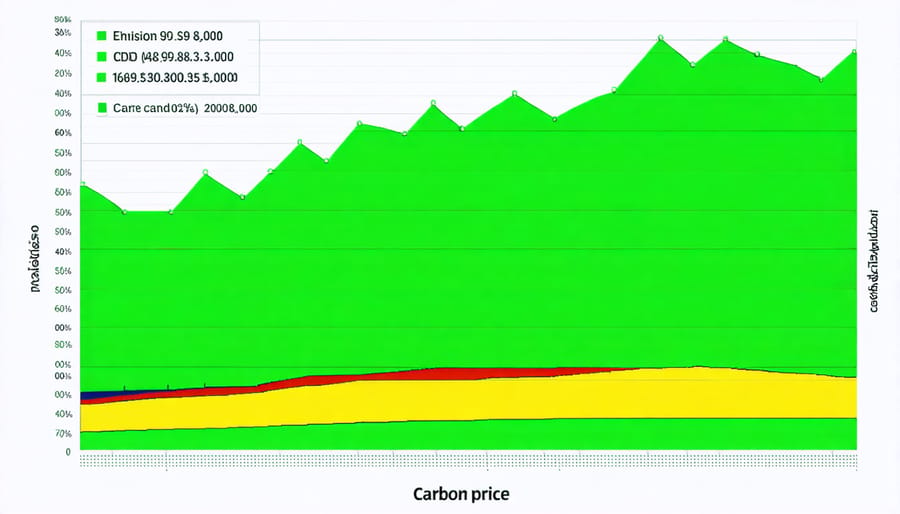Carbon pricing stands as one of the most powerful tools in our fight against climate change, transforming environmental responsibility from a moral imperative into a measurable economic reality. As Australia and nations worldwide grapple with the urgent need to reduce emissions, carbon pricing mechanisms create a clear financial incentive for businesses and industries to innovate towards cleaner operations.
By putting a price on carbon emissions, these mechanisms harness market forces to drive sustainable transformation across the economy. Whether through carbon taxes, emissions trading schemes, or hybrid systems, they create a practical pathway for organizations to measure, manage, and ultimately reduce their carbon footprint. The success of carbon pricing is already evident in regions like the European Union, where emissions trading has helped reduce greenhouse gas emissions while fostering technological innovation.
For Australian businesses navigating the transition to a low-carbon future, understanding these mechanisms isn’t just about compliance—it’s about competitive advantage. As global markets increasingly demand sustainable practices, organizations that master carbon pricing strategies today position themselves as leaders in tomorrow’s green economy. This comprehensive guide explores how carbon pricing works, its various forms, and the opportunities it presents for forward-thinking businesses ready to embrace sustainable transformation.
How Carbon Pricing Transforms Energy Markets
Carbon Tax vs. Cap-and-Trade
Carbon tax and cap-and-trade represent two distinct approaches to pricing carbon emissions, each with its unique advantages. In Australia’s journey towards emissions reduction, we’ve experienced both systems firsthand. The carbon tax, implemented from 2012 to 2014, directly set a price on carbon emissions, providing businesses with clear cost signals for their environmental impact. This straightforward approach helped reduce emissions by about 2% during its brief implementation.
Cap-and-trade systems, like the European Union’s Emissions Trading System (EU ETS), work differently by setting an overall emissions limit and allowing companies to trade permits. Think of it as a game of musical chairs where companies must secure their spot through emission allowances. New Zealand’s Emissions Trading Scheme offers another regional example, demonstrating how market forces can drive innovation in emissions reduction.
Each system has shown promising results in different contexts. The carbon tax provides price certainty, making it easier for businesses to plan investments in cleaner technologies. Meanwhile, cap-and-trade offers more flexibility and can create innovative market solutions. British Columbia’s carbon tax success story shows how revenue recycling can boost public support, while California’s cap-and-trade program demonstrates how linking markets can expand opportunities for cost-effective emissions reduction.
For Australia, understanding these mechanisms is crucial as we shape our climate policy future. Both approaches can work effectively when designed with local conditions in mind.

Direct Benefits for Australian Businesses
Carbon pricing creates tangible opportunities for Australian businesses to thrive in a low-carbon economy. Forward-thinking companies can generate additional revenue streams by selling carbon credits earned through emissions reduction initiatives. For instance, agricultural businesses implementing sustainable farming practices or installing renewable energy systems can earn credits while reducing operational costs.
The mechanism incentivises innovation and technological advancement, positioning Australian companies at the forefront of clean technology development. Many businesses have already transformed their challenges into opportunities by developing new products and services that cater to the growing demand for low-emission solutions.
Local manufacturers can gain a competitive edge by marketing their products as low-carbon alternatives, particularly appealing to environmentally conscious consumers and international markets with strict emissions standards. Companies that act early to reduce their carbon footprint often see improved brand reputation and customer loyalty.
The pricing system also encourages energy efficiency improvements, leading to significant cost savings. Many Australian businesses report substantial reductions in energy bills after implementing emissions reduction strategies. For example, several manufacturing facilities have cut their energy costs by up to 30% through efficiency upgrades prompted by carbon pricing considerations.
Additionally, businesses that embrace carbon pricing often find themselves better prepared for future regulatory changes and market demands, ensuring long-term sustainability and resilience in an increasingly carbon-conscious global economy.
Bioenergy’s Competitive Edge Under Carbon Pricing

Cost Comparisons with Fossil Fuels
When carbon pricing mechanisms are in place, bioenergy solutions often emerge as more economically attractive compared to traditional fossil fuels. In Australia, where the carbon price signal continues to evolve, the cost advantage of bioenergy becomes increasingly evident across various sectors.
A typical coal-fired power plant faces significant additional costs under carbon pricing schemes, with estimates ranging from $30 to $60 per tonne of CO2 emissions. In contrast, bioenergy facilities, which are considered carbon neutral when sourcing sustainable feedstock, avoid these extra charges entirely. This cost advantage translates to competitive energy prices for consumers while supporting environmental goals.
Consider a practical example from regional Victoria, where a timber processing facility switched from natural gas to a biomass boiler system. The initial investment was offset within four years, primarily due to carbon pricing benefits and reduced fuel costs. The facility now saves approximately $400,000 annually while eliminating 4,000 tonnes of CO2 emissions.
Looking at transport fuels, biodiesel produced from waste cooking oil becomes notably more competitive when carbon prices exceed $40 per tonne. Several Australian transport companies have already made the switch, reporting fuel cost savings of 15-20% while reducing their carbon tax liability.
The agricultural sector also demonstrates compelling economics. Farms utilizing biogas digesters for waste management not only avoid carbon prices on methane emissions but generate additional revenue through energy production and organic fertilizer sales. A dairy farm in New South Wales exemplifies this success, achieving complete energy self-sufficiency while creating a new income stream from excess power generation.
These real-world examples show how carbon pricing helps level the playing field, making sustainable bioenergy solutions increasingly attractive for Australian businesses and industries.
Agricultural Benefits and Opportunities
Carbon pricing mechanisms present significant opportunities for Australian farmers to diversify their income streams while contributing to climate change mitigation. Through bioenergy production, farmers can transform agricultural waste and dedicated energy crops into valuable renewable energy resources, creating a win-win situation for both their bottom line and the environment.
One of the most promising aspects is the ability to generate carbon credits through sustainable farming practices and bioenergy production. By implementing methods such as crop residue management, biochar production, and dedicated energy crop cultivation, farmers can earn additional revenue while reducing their carbon footprint. These practices not only sequester carbon but also improve soil health and farm productivity.
The establishment of biomass supply chains offers farmers new market opportunities. By growing energy crops like oil mallee, short-rotation coppice eucalyptus, or switchgrass, farmers can supply feedstock to bioenergy facilities while maintaining traditional agricultural activities. This diversification helps protect against market fluctuations and seasonal variations in income.
Several success stories demonstrate the potential. In Western Australia, a group of wheat farmers collectively supplies agricultural residues to a local biogas facility, earning carbon credits while solving waste management challenges. Similarly, Victorian dairy farmers have installed biodigesters to process animal waste, generating electricity for on-farm use and selling excess power back to the grid.
The carbon pricing framework also encourages investment in on-farm bioenergy infrastructure. Farmers can access grants and incentives to establish small-scale bioenergy plants, creating additional revenue streams through electricity generation and heat production. This approach not only reduces operational costs but also enhances energy independence and resilience.
As carbon markets mature, these opportunities are expected to expand, offering farmers increasingly attractive pathways to participate in Australia’s clean energy future while maintaining profitable agricultural operations.
Success Stories: Carbon Pricing in Action
International Success Models
Several countries have demonstrated remarkable success with carbon pricing mechanisms, offering valuable lessons for Australia’s sustainable future. The European Union’s Emissions Trading System (EU ETS), launched in 2005, stands as the world’s largest carbon market, achieving a 35% reduction in emissions from power and manufacturing sectors by 2019.
Sweden’s carbon tax success story is particularly noteworthy. Implemented in 1991, their system has achieved a 25% reduction in overall emissions while maintaining strong economic growth. The Swedish model combines high carbon prices with targeted support for industry innovation, proving that environmental protection and economic prosperity can coexist.
British Columbia, Canada, introduced a revenue-neutral carbon tax in 2008 that has become a global benchmark. The province’s emissions decreased by 5-15% while GDP growth remained strong. Their approach of returning carbon tax revenue to citizens through tax cuts and rebates has garnered strong public support.
New Zealand’s Emissions Trading Scheme demonstrates successful integration of forestry and agriculture sectors – particularly relevant for Australia’s diverse economy. Their system has encouraged significant forest preservation and new plantings, creating valuable carbon sinks while supporting indigenous land management practices.
These international examples show that well-designed carbon pricing mechanisms can effectively reduce emissions while fostering innovation and maintaining economic competitiveness, offering valuable insights for Australia’s carbon pricing journey.

Australian Pioneers
Several Australian businesses have demonstrated remarkable success under carbon pricing initiatives, proving that environmental responsibility and economic growth can go hand in hand. Visy Industries, one of Australia’s largest manufacturing and recycling companies, invested heavily in clean energy solutions and waste reduction programs, resulting in a 30% decrease in their carbon footprint while expanding their operations.
Adelaide Brighton Cement took an innovative approach by implementing energy-efficient technologies and alternative fuel sources, leading to significant cost savings and reduced emissions. Their proactive stance not only helped them adapt to carbon pricing but also positioned them as industry leaders in sustainable manufacturing.
The agriculture sector has also embraced carbon pricing opportunities. Sundrop Farms in Port Augusta revolutionized greenhouse farming by using solar thermal technology for desalination and climate control. Their success story demonstrates how carbon pricing can drive innovation and create new business models.
Even smaller enterprises have found success. Green’s Foods in Melbourne transformed their operations by installing solar panels and implementing energy-efficient production processes. This transition not only offset their carbon price exposure but also reduced their operating costs by 25%.
These pioneers show that carbon pricing can catalyze positive change, driving innovation and creating competitive advantages while contributing to Australia’s emissions reduction goals. Their experiences provide valuable blueprints for other businesses considering similar transformations.
Making Carbon Pricing Work for You
To make carbon pricing work for your organization, start by conducting a thorough emissions audit. Understanding your carbon footprint creates a baseline for strategic planning and helps identify quick wins for emissions reduction. Many Australian businesses have found success by starting with energy efficiency measures, which often pay for themselves through reduced operational costs.
Develop a carbon management strategy that aligns with your business goals. This might include setting science-based targets for emissions reduction, investing in renewable energy infrastructure, or implementing energy-efficient technologies. Consider forming a dedicated sustainability team to oversee these initiatives and track progress.
Take advantage of available resources and support programs. The Australian Government offers various incentives and grants for businesses transitioning to low-carbon operations. Network with industry peers and join sustainability forums to share experiences and learn from others’ successes.
For maximum benefit, integrate carbon pricing into your decision-making processes. When evaluating new projects or investments, include potential carbon costs in your financial analysis. This forward-thinking approach helps future-proof your operations and can reveal unexpected opportunities for innovation and cost savings.
Consider investing in carbon offset projects while working on direct emissions reductions. Many Australian organizations have found success partnering with local Indigenous land management projects or supporting renewable energy initiatives. These investments not only offset emissions but often deliver additional social and environmental benefits.
Build carbon awareness into your supply chain management. Work with suppliers to understand and reduce upstream emissions, and consider implementing sustainable procurement policies. Some organizations have successfully negotiated better terms with suppliers who demonstrate strong environmental performance.
Finally, communicate your carbon reduction efforts to stakeholders. Transparent reporting on progress builds trust and can enhance your organization’s reputation. Many successful Australian businesses have turned their carbon reduction initiatives into powerful marketing advantages, demonstrating leadership in sustainability while improving their bottom line.
Remember, carbon pricing isn’t just a compliance issue – it’s an opportunity to innovate, reduce costs, and position your organization for success in a low-carbon future.
Carbon pricing mechanisms stand as powerful tools in our collective effort to combat climate change and transition to a sustainable future. Throughout this discussion, we’ve seen how these systems can effectively reduce emissions while driving innovation and economic growth. From emissions trading schemes to carbon taxes, each approach offers unique advantages in helping Australia and the global community meet their climate goals.
The success stories from countries like Sweden, Canada, and our own initiatives here in Australia demonstrate that well-designed carbon pricing can work effectively when supported by clear policy frameworks and stakeholder engagement. These examples show us that the transition to a low-carbon economy is not just possible – it’s already happening.
As we look ahead, the role of carbon pricing will become increasingly important in achieving our national and global climate targets. For businesses, early adoption of carbon pricing strategies can provide competitive advantages and help future-proof operations. For communities, these mechanisms can drive cleaner air, better health outcomes, and sustainable job creation.
The time for action is now. Whether you’re a policy maker, business leader, or concerned citizen, supporting effective carbon pricing mechanisms is crucial. By engaging with local representatives, participating in public consultations, and advocating for robust carbon pricing policies, we can all contribute to building a more sustainable future for Australia.
Let’s embrace these powerful tools and work together to create meaningful change in our journey toward a cleaner, more prosperous tomorrow.

